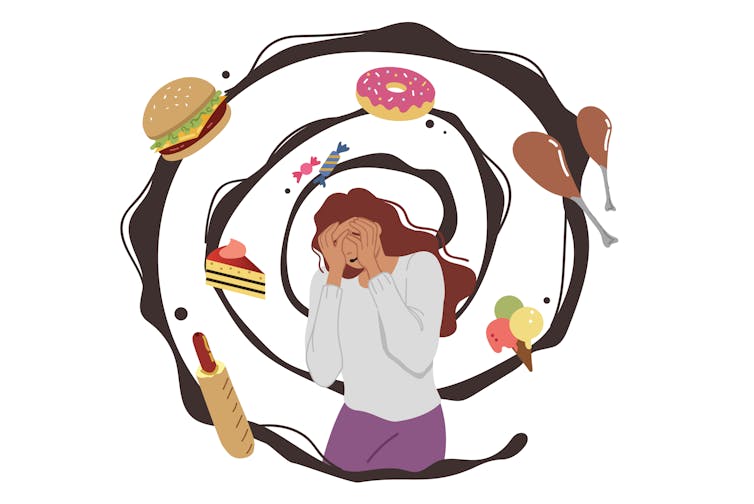Can you really be addicted to food? Researchers are uncovering convincing similarities to drug addic
A consensus is emerging among scientists that certain foods are addictive for some people. But questions remain about which foods, which people and why.

People often joke that their favorite snack is “like crack” or call themselves “chocoholics” in jest.
But can someone really be addicted to food in the same way they could be hooked on substances such as alcohol or nicotine?
As an addiction psychiatrist and researcher with experience in treating eating disorders and obesity, I have been following the research in this field for the past few decades. I have written a textbook on food addiction, obesity and overeating disorders, and, more recently, a self-help book for people who have intense cravings and obsessions for some foods.
While there is still some debate among psychologists and scientists, a consensus is emerging that food addiction is a real phenomenon. Hundreds of studies have confirmed that certain foods – often those that are high in sugar and ultraprocessed – affect the brains and behavior of certain people similarly to other addictive substances such as nicotine.
Still, many questions remain about which foods are addictive, which people are most susceptible to this addiction and why. There are also questions as to how this condition compares to other substance addictions and whether the same treatments could work for patients struggling with any kind of addiction.
How does addiction work?
The neurobiological mechanisms of addiction have been mapped out through decades of laboratory-based research using neuroimaging and cognitive neuroscience approaches.
Studies show that preexisting genetic and environmental factors set the stage for developing an addiction. Regularly consuming an addictive substance then causes a rewiring of several important brain systems, leading the person to crave more and more of it.
This rewiring takes place in three key brain networks that correspond to key functional domains, often referred to as the reward system, the stress response system and the system in charge of executive control.
First, using an addictive substance causes the release of a chemical messenger called dopamine in the reward network, which makes the user feel good. Dopamine release also facilitates a neurobiological process called conditioning, which is basically a neural learning process that gives rise to habit formation.
As a result of the conditioning process, sensory cues associated with the substance start to have increasing influence over decision-making and behavior, often leading to a craving. For instance, because of conditioning, the sight of a needle can drive a person to set aside their commitment to quit using an injectable drug and return to it.
Second, continued use of an addictive substance over time affects the brain’s emotional or stress response network. The user’s body and mind build up a tolerance, meaning they need increasing amounts of the substance to feel its effect. The neurochemicals involved in this process are different than those mediating habit formation and include a chemical messenger called noradrenaline and internally produced opioids such as endorphins. If they quit using the substance, they experience symptoms of withdrawal, which can range from irritability and nausea to paranoia and seizures.
At that point, negative reinforcement kicks in. This is the process by which a person keeps going back to a substance because they’ve learned that using the substance doesn’t just feel good, but it also relieves negative emotions. During withdrawal from a substance, people feel profound emotional discomfort, including sadness and irritability. Negative reinforcement is why someone who is trying to quit smoking, for instance, will be at highest risk of relapse in the week just after stopping and during times of stress, because in the past they’d normally turn to cigarettes for relief.
Third, overuse of most addictive substances progressively damages the brain’s executive control network, the prefrontal cortex, and other key parts of the brain involved in impulse control and self-regulation. Over time, the damage to these areas makes it more and more difficult for the user to control their behavior around these substances. This is why it is so hard for long-term users of many addictive substances to quit.
What evidence is there that food is addictive?
Many studies over the past 25 years have shown that high-sugar and other highly pleasurable foods – often foods that are ultraprocessed – act on these brain networks in ways that are similar to other addictive substances. The resulting changes in the brain fuel further craving for and overuse of the substance – in this case, highly rewarding food.
Clinical studies have demonstrated that people with an addictive relationship to food demonstrate the hallmark signs of a substance use disorder.
Studies also indicate that for some people, cravings for highly palatable foods go well beyond just a normal hankering for a snack and are, in fact, signs of addictive behavior. One study found that cues associated with highly pleasurable foods activate the reward centers in the brain, and the degree of activation predicts weight gain. In other words, the more power the food cue has to capture a person’s attention, the more likely they are to succumb to cravings for it.
Multiple studies have also found that suddenly ending a diet that’s high in sugar can cause withdrawal, similar to when people quit opioids or nicotine.
Excessive exposure to high-sugar foods has also been found to reduce cognitive function and cause damage to the prefrontal cortex and hippocampus, the parts of the brain that mediate executive control and memory.
In another study, when obese people were exposed to food and told to resist their craving for it by ignoring it or thinking about something else, their prefrontal cortexes were more active compared with nonobese individuals. This indicates that it was more difficult for the obese group to fight their cravings.

Finding safe treatments for patients struggling with food
Addiction recovery is often centered on the idea that the fastest way to get well is to abstain from the problem substance. But unlike nicotine or narcotics, food is something that all people need to survive, so quitting cold turkey isn’t an option.
In addition, eating disorders such as bulimia nervosa and binge-eating disorder often occur alongside addictive eating. Most psychologists and psychiatrists believe these illnesses have their root cause in excessive dietary restriction.
For this reason, many eating disorder treatment professionals balk at the idea of labeling some foods as addictive. They are concerned that encouraging abstinence from particular foods could trigger binge eating and extreme dieting to compensate.
A way forward
But others argue that, with care, integrating food addiction approaches into eating disorders treatment is feasible and could be lifesaving for some.
The emerging consensus around this link is moving researchers and those who treat eating disorders to consider food addiction in their treatment models.
One such approach might look like the one described to me by addiction psychiatrist and eating disorders specialist Dr. Kim Dennis. In line with traditional eating disorder treatment, nutritionists at her residential clinic strongly discourage their patients from restricting calories. At the same time, in line with traditional addiction treatment, they help their patients to consider significantly reducing or completely abstaining from particular foods to which they have developed an addictive relationship.
Additional clinical studies are already being carried out. But going forward, more studies are needed to help clinicians find the most effective treatments for people with an addictive relationship with food.
Efforts are underway by groups of psychologists, psychiatrists, neuroscientists and mental health providers to get “ultraprocessed food use disorder,” also known as food addiction, into future editions of diagnostic manuals such as the Diagnostic and Statistical Manual of Mental Disorders and the World Health Organization’s International Classification of Diseases.
Beyond acknowledging what those treating food addiction are already seeing in the field, this would help researchers get funding for additional studies of treating food addiction. With more information about what treatments will work best for whom, those who have these problems will no longer have to suffer in silence, and providers will be better equipped to help them.
I have two books for sale which address food addiction, and I could benefit financially from increased interest in the food addiction topic: Wilcox C.E. Food Addiction Obesity and Disorders of Overeating: An Evidenced Based Assessment and Clinical Guide. (2021) Springer Wilcox C. Rewire Your Food-Addicted Brain: Fight Cravings and Break Free from a High-Sugar Ultra-Processed Diet. (2025) New Harbinger Publications
Read These Next
As a former federal judge, I’m concerned by a year of challenges to the US justice system
A university president who’s a former federal judge looks at the rule of law and the Trump administration’s…
AI’s errors may be impossible to eliminate – what that means for its use in health care
Many health symptoms can be caused by multiple illnesses – if AI can’t tell the difference between…
AI-generated political videos are more about memes and money than persuading and deceiving
Don’t discount the threat of AI political videos fooling people, but for now, they’re mostly about…




